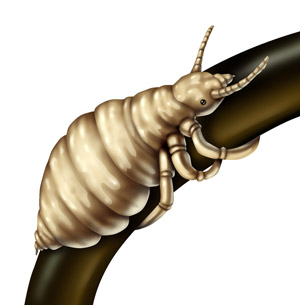Spraying Your Home Won’t Affect Head Lice
By Chris Williams on November 28, 2013.
 Now that school is back in session, questions are coming in about head lice and whether or not homes or schools should be treated to kill the lice infesting children. The short answer is “no,” treating a home or school will not affect head lice and will just expose people to pesticides unnecessarily. Head lice are a personal medical issue, not a pest control issue. Read on to learn more about the facts of lice.
Now that school is back in session, questions are coming in about head lice and whether or not homes or schools should be treated to kill the lice infesting children. The short answer is “no,” treating a home or school will not affect head lice and will just expose people to pesticides unnecessarily. Head lice are a personal medical issue, not a pest control issue. Read on to learn more about the facts of lice.
The Facts of Lice
- Head lice are small, wingless insects. They are about the size of a sesame seed but light gray with pincer-like claws that they use to hold onto hairs. They are not easily removed from the hairs.
- Head lice infest people’s hair and suck blood from their scalps. Head lice infest head hair while the related pubic lice infest hair in the groin area.
- Female head lice glue their eggs (called nits) directly onto the hair shaft. Nits are visible and are found most often at the nape of the neck and behind the ears, but also in eyebrows and eyelashes.The attached white egg cases remain on the hair even after hatching, as the hair grows out.
- Head lice are sometimes confused with bed bugs. They are similar in size and both suck blood from people. An important difference is that head lice do not wander from their host person, while bed bugs easily wander and hitchhike to new locations on belongings. Head lice remain on the head where they feed. Bed bugs feed on a person and then leave to hide in cracks and crevices. See “Don’t Confuse Head Lice and Bed Bugs.”
- Head lice do not transmit any diseases but they often cause itching and discomfort.
- Anyone can get head lice but they most often infest school-age children, mostly because of the close contact of children at school and when playing.
- Head lice rarely leave the head that they are feeding on but can be spread when combs, brushes, hats, scarves, and sleeping mats are shared, or by direct head-to-head contact.They are not normally spread by picking them up from couches, desks, chairs, or other shared furniture or objects.
- Treating homes or schools for head lice does not affect the head lice because they remain on the child’s head and would not come into contact with any applied insecticides. If separated from the head, head lice usually die in 24-48 hours.
- Treatment for head lice involves special shampoos and thorough combing to remove lice and nits from the hair. Laundering of the child’s bedding, clothing, hats, and scarves in hot water and drying at high heat will kill lice not on the head.
- The National Pediculosis Association (NPA) has an excellent website for more information on dealing with head lice.